PCI Express Signal Mapping for
VITA 46 (VPX)
VITA 46.4-200x
Draft 0.3
August 20, 2007
This draft standard is being prepared by the VITA Standards
Organization (VSO) and is unapproved.
Do not specify or claim conformance
to this draft standard
VSO is a Public Domain Administrator of this draft standard
and guards the contents from change except by sanctioned
meetings of the working group under due process.
VITA Standards Organization
PO. Box 19658
Fountain Hills, AZ 85269
Ph: 480-837-7486
URL: http://www.vita.com
Page 1 of 17 Do not specify or claim conformance to this document
VITA 46.4-200x/D0.3
�
Table of Contents
1
3
2.1
2.2
2.2.1
2.2.2
1.1
1.2
1.3
1.4
Introduction................................................................................................................. 5
Objective............................................................................................................. 5
PCI Express Technology Overview.................................................................... 5
Terminology........................................................................................................ 6
References........................................................................................................... 8
2 VITA 46.4 Compliance............................................................................................... 9
General Requirements for VITA 46.4 compliance............................................. 9
Connectors Pin Mapping..................................................................................... 9
P0, P2, P3 P4, P5 and P6 Connector Signal Mapping ................................ 9
P1 - Connector Signal Mapping.................................................................. 9
Link Configuration............................................................................................ 11
Glyphs............................................................................................................... 12
Alignment and Keying...................................................................................... 12
Payload Module Requirements for VITA46.4 compliance ...................................... 13
3U Module Specific Requirements................................................................... 13
6U Module Specific Requirements................................................................... 13
4 Backplane Specific Requirements for VITA46.4 compliance.................................. 13
Electrical Budgets ..................................................................................................... 14
5
AC Coupling Capacitors................................................................................... 14
Impedance......................................................................................................... 14
Insertion Loss.................................................................................................... 14
Jitter................................................................................................................... 15
Lane-to-Lane Skew........................................................................................... 16
Intra-Pair Skew ................................................................................................. 16
Signal Routing Recommendations............................................................................ 17
5.1
5.2
5.3
5.4
5.5
5.6
2.3
2.4
2.5
3.1
3.2
6
Page 2 of 17 Do not specify or claim conformance to this document
VITA 46.4-200x/D0.3
�
Attendee
(alphabetical by last name)
Randy Banton
Rodger Bird
David Compston
Stewart Dewar
Gerard Drewek
Steve Edwards
Val Gueorguiev
Greg Griffith
Mike Gust
Mike Hasenfratz
Melissa Heckman
Dean Holman
Richard Jaenicke
Aaron Kaiway
Emil Kheyfets
Jing Kwok
Andreas Lenkisch
Michael Monroe
André Moorma
Gene Palmer
Gerry Palmer
Elwood Parsons
Bob Patterson
Doug Patterson
David Pepper
Brian Rach
Andy Reddig
Jim Robles
John Rynearson
Jeff Smith
Andrew Spence
Ivan Straznicky
Eran Strod
Bob Sullivan
Bruce Thomas
Dan Toohey
Bob Whyms
Randy White
Company
Mercury
Boeing
Radstone
CWCEC-Ottawa
GD-AIS
CWCEC-Leesburg
Aitech
Tyco
Mercury
Northrop Grumman
Bustronic
Mercury
Mercury
Spectrum Signal
CWCEC-S Clarita
CWCEC-Ottawa
Pentair/Schroff
Bustronic Corp.
Rockwell
Radstone
DRS Tactical Systems
Foxconn
Tyco
Aitech
GE Fanuc
Rockwell
TEK Microsystems
Boeing
VITA
GHz Systems Inc.
Amphenol
CWCEC-Ottawa
Mercury
Hybricon
CWCEC-S Clarita
Mercury
Northrop Grumman
CWCEC-Ottawa
TASK GROOP
At the time this standard was competed, task group membership included:
Page 3 of 17 Do not specify or claim conformance to this document
VITA 46.4-200x/D0.3
�
Comments, Corrections, or Additions
Comments, corrections, or additions to this proposed standard may be forwarded to:
Val Gueorguiev, Draft Editor
Aitech Defense Systems Inc.
9301 Oakdale Avenue
Chatsworth, CA 91311
(818) 350-6814
EMAIL: vgueorguiev@rugged.com
VSO and Other Standards
Information about other standards being developed by VSO as well as VME Product
Directories, VME Handbooks, and general information about the VME market is
available from the VITA office listed on the front cover.
Draft Summary
This is draft 02of this standard. The original content of this draft standard was presented
and agreed upon at the xxx VSO meeting. See the draft history for a summary list of the
major changes made to each draft.
Draft History
Draft No.
0.1
Date
02/20/2006
0.2
0.3
05/06/2006
08/20/2007
Comments & Major Changes/Updates
Preliminary Draft
Removed 2X PCI Express Links from Table 4.
Updated Section 5 per recommendations provided by Brian Rach.
Update per minutes from the VPX meeting in Vancouver 18, 19-Jul-2007.
Issues to be resolved
1
2
3
Page 4 of 17 Do not specify or claim conformance to this document
VITA 46.4-200x/D0.3
�
1 Introduction
The VITA 46 standard regulates the standardization of switched serial interconnects for
VME bus applications, with specific concern taken to allow deployment in ruggedized
environments.
The VITA 46.0 base standard defines the physical features of VITA 46 components.
The VITA 46.4 standard is a subset of VITA 46 standard and defines the implementation
of PCI Express, high speed serial interconnect interface within VITA 46.0 form factor
constraints.
1.1 Objective
The objectives of this document are:
- To assign 16 PCI Express Lanes over the data links defined in VITA 46.0.
- To recommend signal mapping for 32 PCI Express Lanes over the data links
defined in VITA 46.0.
- To define requirements and constraints for the implementation of PCI Express
Physical Layer in VITA 46.0 environment.
To define auxiliary signals necessary to implement PCI Express interface in a
system environment.
-
The guidelines and design rules defined in this standard are intended to be consistent with
the applicable sections of the PCI Express Specification. It is expected that VITA 46.4
products will comply with PCI Express Transaction, Data Link and Physical Layer
Specifications in order to maximize interoperability with other PCI Express hardware and
software products.
1.2 PCI Express Technology Overview.
PCI Express provides signaling architecture supporting high-speed serial communication
and allows a smooth transition from PCI to a faster, more scalable interconnect
technology.
PCI Express defines three logical layers: the Transaction Layer, the Data Link Layer and
the Physical Layer. The Transaction Layer and the Data Link Layer generate, transmit
and receive data packets. The Physical Layer converts the information into appropriate
serialized format and transmits it across the PCI Express Link. The PCI Express fabric is
composed of point-to-point Links that interconnect the components of the fabric –
Endpoint, Root Complex, Switch and Bridge. The First Generation of PCI Express
Technology defines a signaling rate of 2.5 Gigabit/second /Lane and uses encoding
scheme supporting embedded data clock.
PCI Express Technology develops on the foundation of the PCI architecture and provides
complete backwards compatibility and interoperability with the existing PCI software,
ensuring successful migration path at system level and broad industry support.
Page 5 of 17 Do not specify or claim conformance to this document
VITA 46.4-200x/D0.3
�
1.3 Terminology
Specification Key Words
To avoid confusion and to make very clear what the requirements for compliance are,
many of the paragraphs in this standard are labeled with keywords that indicate the type
of information they contain. These keywords are listed below:
Rule
Recommendation
Suggestion
Permission
Observation
Any text not labeled with one of these keywords should be interpreted as descriptive in
nature. These will be written in either a descriptive or a narrative style. The keywords are
used as follows:
Rule .:
Rules form the basic framework of this draft standard. They are sometimes expressed in
text form and sometimes in the form of figures, tables or drawings. All rules shall be
followed to ensure compatibility between board and backplane designs. All rules use the
"shall" or "shall not" words to emphasize the importance of the rule. The "shall" or "shall
not" words are reserved exclusively for stating rules in this draft standard and are not
used for any other purpose.
Recommendation .:
Wherever a recommendation appears, designers would be wise to take the advice given.
Doing otherwise might result in poor performance or awkward problems.
Recommendations found in this standard are based on experience and are provided to
designers to speed their traversal of the learning curve. All recommendations use the
"should" or "should not" words to emphasize the importance of the recommendation. The
"should" or "should not" words are reserved exclusively for stating recommendations in
this draft standard and are not used for any other purpose.
Permission .:
In some cases a rule does not specifically prohibit a certain design approach, but the
reader might be left wondering whether that approach might violate the spirit of the rule
or whether it might lead to some subtle problem. Permissions reassure the reader that a
certain approach is acceptable and will cause no problems. All permissions use the "may"
words to emphasize the importance of the permission. The lower-case "may" words are
reserved exclusively for stating permissions in this draft standard and are not used for any
other purpose.
Observation .:
Observations do not offer any specific advice. They usually follow naturally from what
has just been discussed. They spell out the implications of certain rules and bring
attention to things that might otherwise be overlooked. They also give the rationale
behind certain rules so that the reader understands why the rule must be followed.
Page 6 of 17 Do not specify or claim conformance to this document
VITA 46.4-200x/D0.3
�
VITA 46 Definitions
The following terms may be used within the body of the specification. In this context,
they have the following meanings:
5x2 wafers- A single-ended wafer providing five signal contacts and two ground contacts
Air cooled – a plug-in module which is intended to have heat removed by transfer to an
air stream flowing over the module
Chassis Ground – See Safety Ground.
Conduction cooled – a plug-in module which is intended to have heat removed by
transfer to the chassis through mechanical contact with a chassis component
Dedicated System – A system designed for a single use or application; not available to
general users. Such a system will usually embody a feature which precludes full
compliance with this standard.
Differential Wafer - A pair of wafers designed for the connection of high speed (up to 5
GBaud) signaling intended for use with differential pair signals, such as LVDS.
ESD – Electrostatic discharge.
Ground – Unless otherwise specified the term Ground means logic ground or signal
ground, not safety ground. Also referred to as RF Ground. See Safety Ground and RF
Ground.
MultiGig RT2 7-Row – A family of connectors, or their equivalent, used in VITA 46
systems for high speed interconnections.
Power Wafer – A wafer providing two contacts which are intended to be used to supply
prime power to a plug-in module.
PS Module – A plug-in module which provides an allocation of differential connectors in
addition to an allocation of single ended connectors, suitable for implementation of
both serial fabric and parallel bus interconnection in the same module. Thus Parallel
Serial (PS) to indicate the combination.
RF Ground - A distributed low impedance common reference between plug-in module
circuitry/shields and other electrical equipment (rack, other plug-in modules, and power
sources). See Safety Ground and Ground.
Safety Ground - Plug-in module features that ensure hazardous voltages are not present
on accessible hardware under single fault conditions. See Ground and RF Ground.
SS Module – A plug-in module which provides differential connectors in all connector
locations, suitable for serial fabric or high speed I/O interconnections. Thus Serial Serial
(SS) to indicate fabric connections are the only connections anticipated to be used.
VME Board – A plug-in module that complies with the ANSI/VITA-1.1, VME64
Extensions standard.
Vs – Notation representing Prime Power from the system to the plug-in module.
VXS – a VMEbus Switched Serial (VITA-41) payload module
PCI Express Definitions
Endpoint – A device with a Type 00h configuration space header.
Lane – A set of differential signal pairs – one pair for transmission, one pair for
reception.
Link – A collection of two ports and their interconnecting Lanes. Dual simplex
communication path between two components.
Page 7 of 17 Do not specify or claim conformance to this document
VITA 46.4-200x/D0.3
�
Packet – A fundamental unit of information transfer consisting of header that, in some
cases, is followed by data payload.
Root Complex – An entity that includes a Host Bridge and one or more Root Ports.
1.4 References
The following publications are used in conjunction with this standard. In the event that
one of these standards is revised, the revised standard should be used unless it conflicts
with this standard.
The following standards are available from the VMEbus International Trade
Association. http://www.vita.com
ANSI/VITA 1-2002 American National Standard for VME64
ANSI/VITA 1.1-1997 American National Standard for VME64 Extensions
ANSI/VITA 46.0 - 2005-46.0 Advanced Module Format for Fabric Based systems
The following are available from their respective maintainers:
IEEE 1101.1-1998, IEEE Standards for Mechanical Core Specifications for
Microcomputers Using IEC 603-2 Connectors
IEEE 1101.2-1992 IEEE Standard for Mechanical Core Specifications for
Conduction-Cooled Eurocards
PCI Express Base Specification
Page 8 of 17 Do not specify or claim conformance to this document
VITA 46.4-200x/D0.3
�
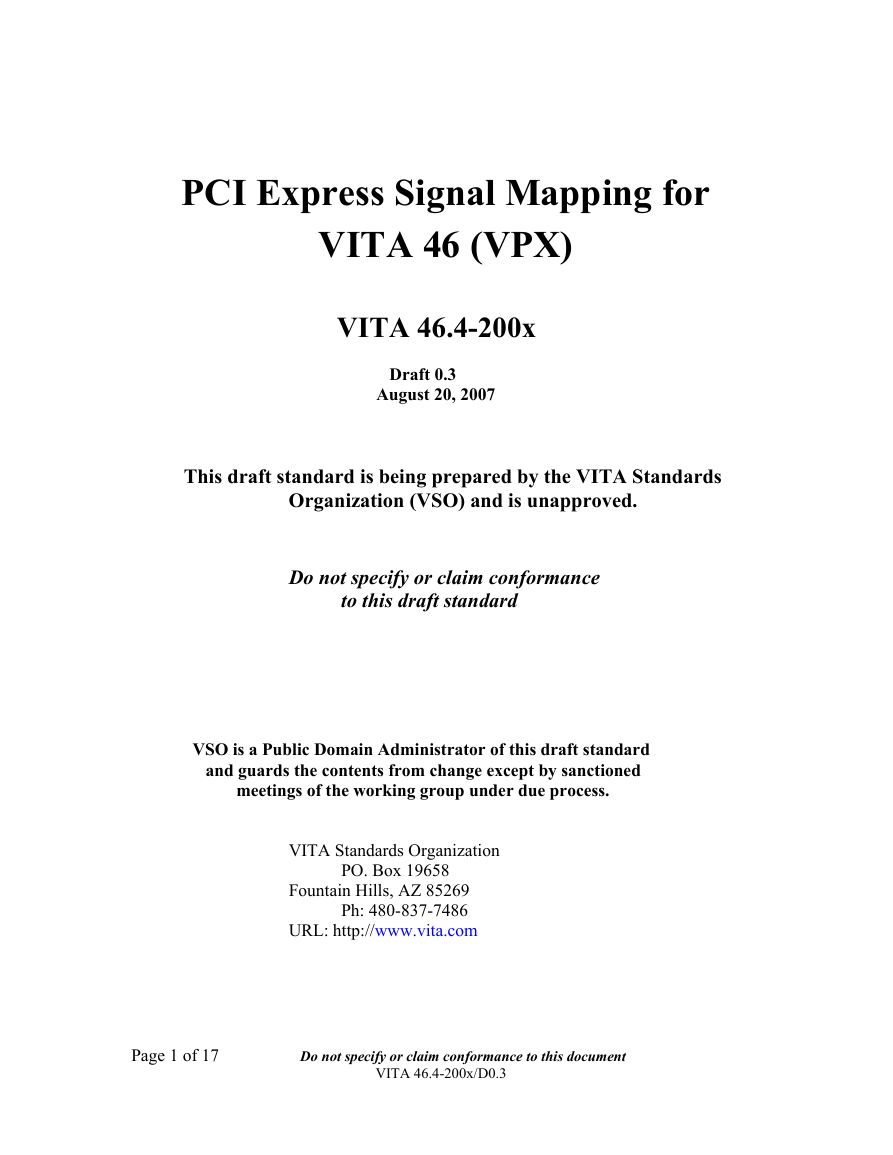
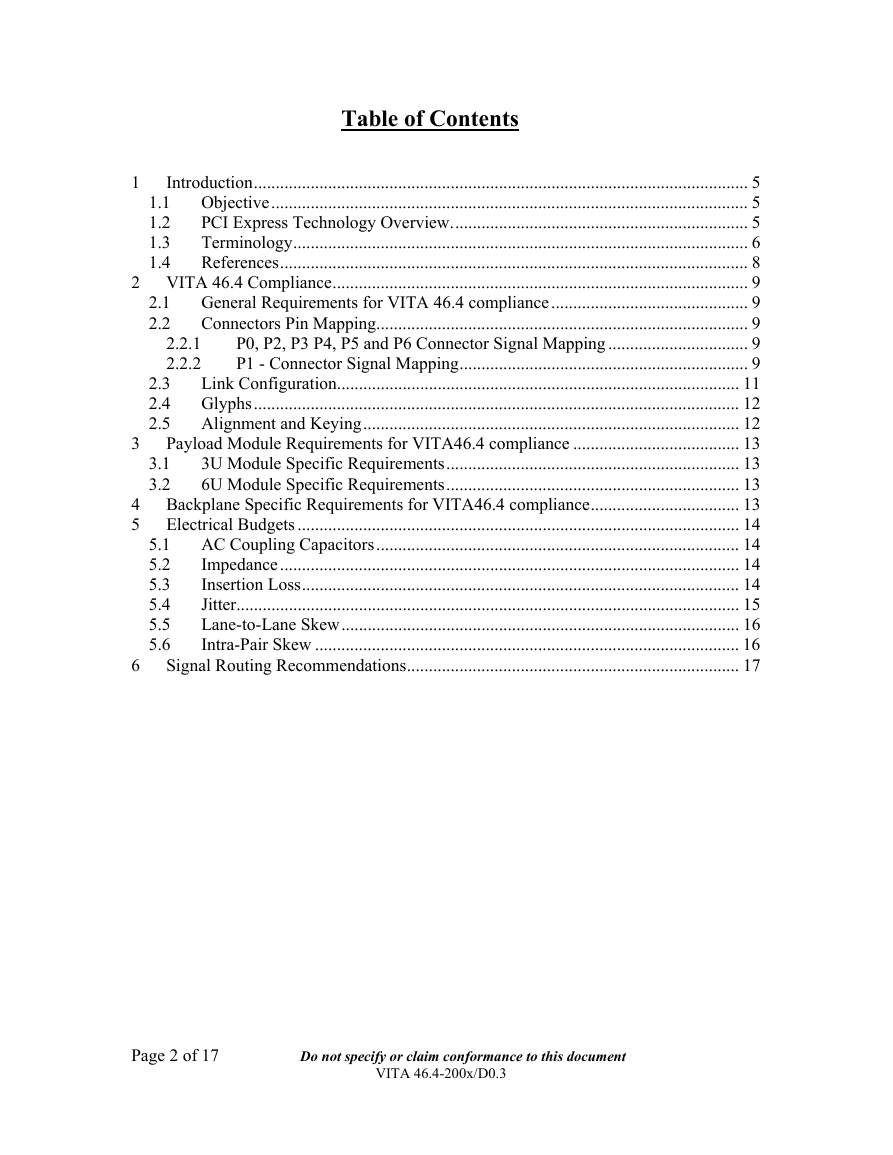
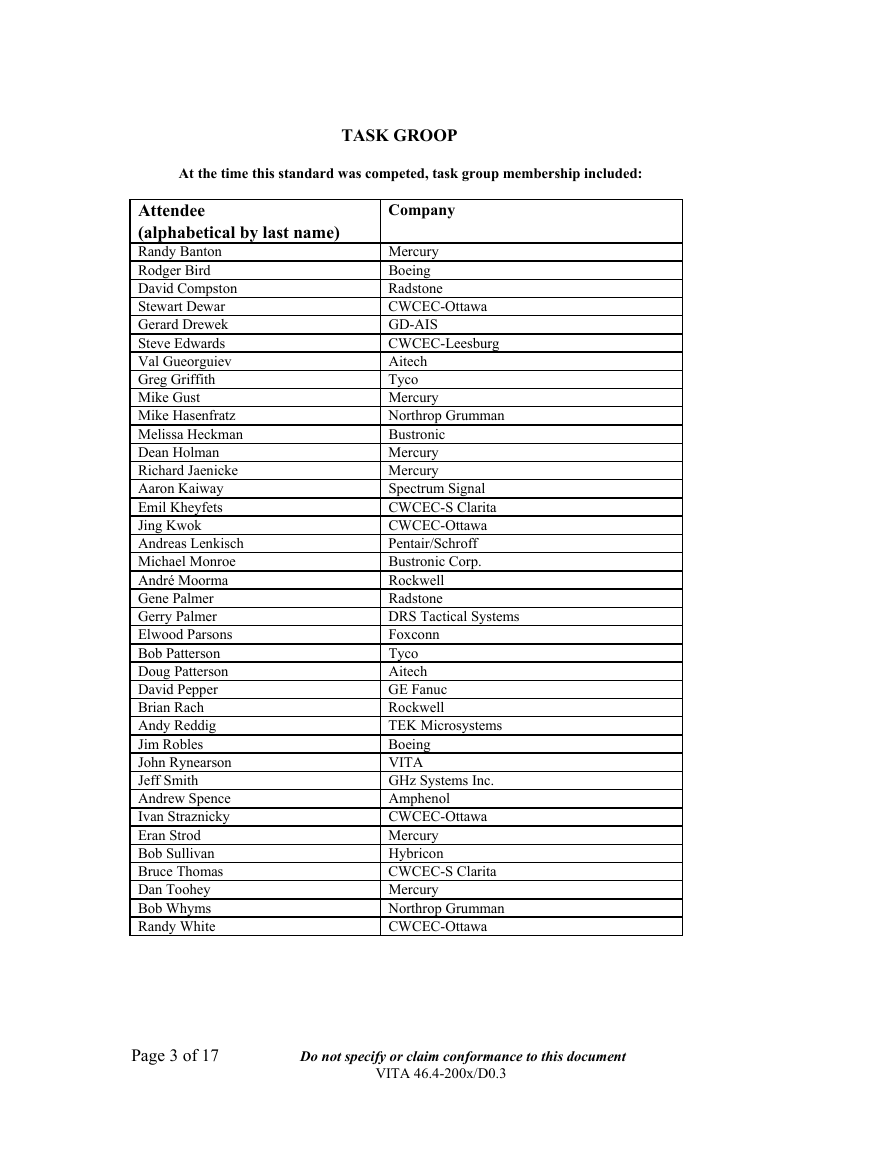
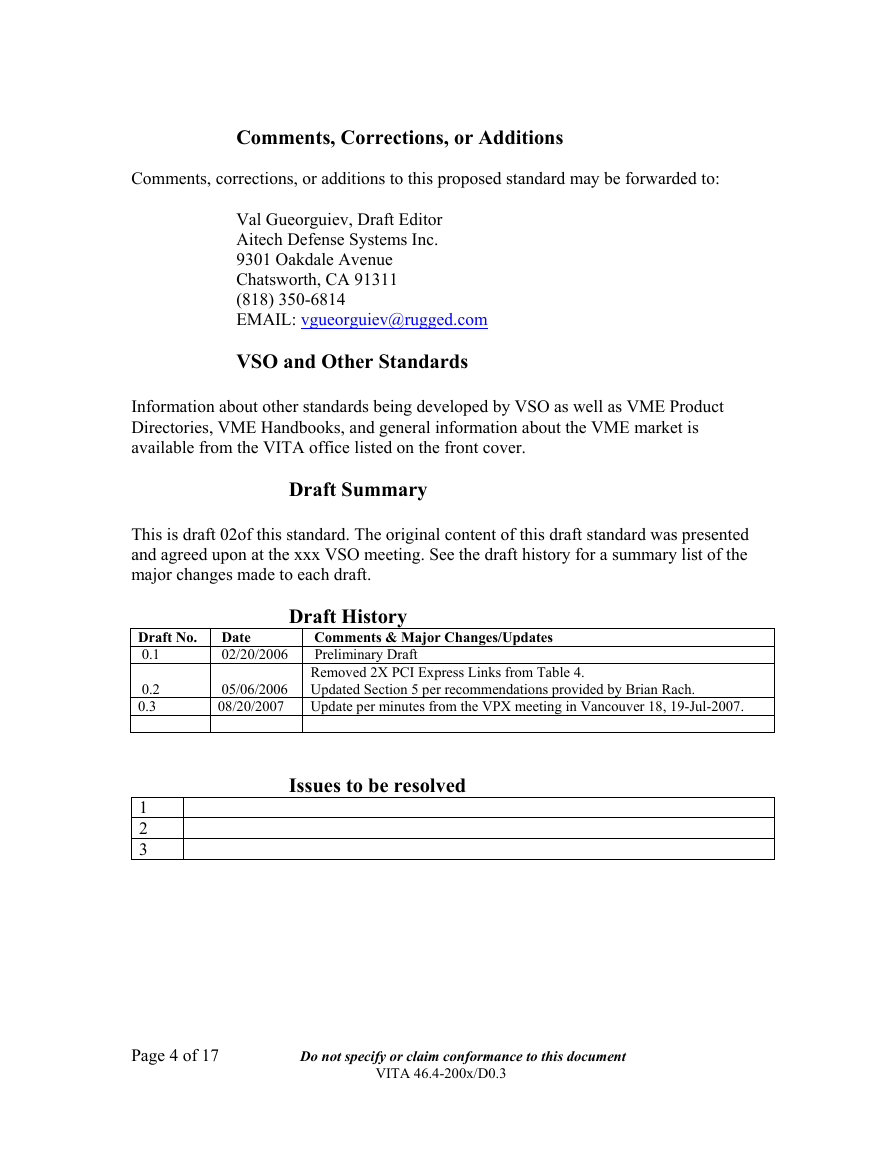
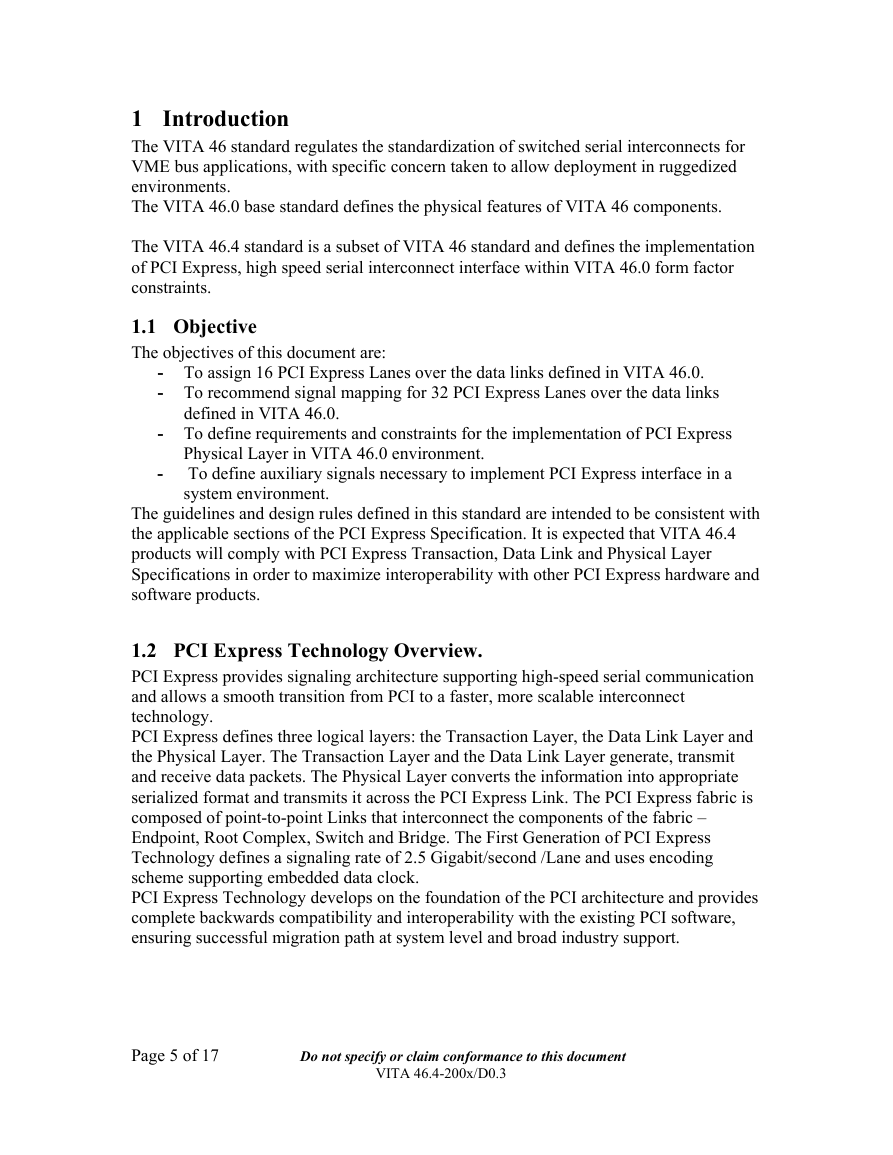
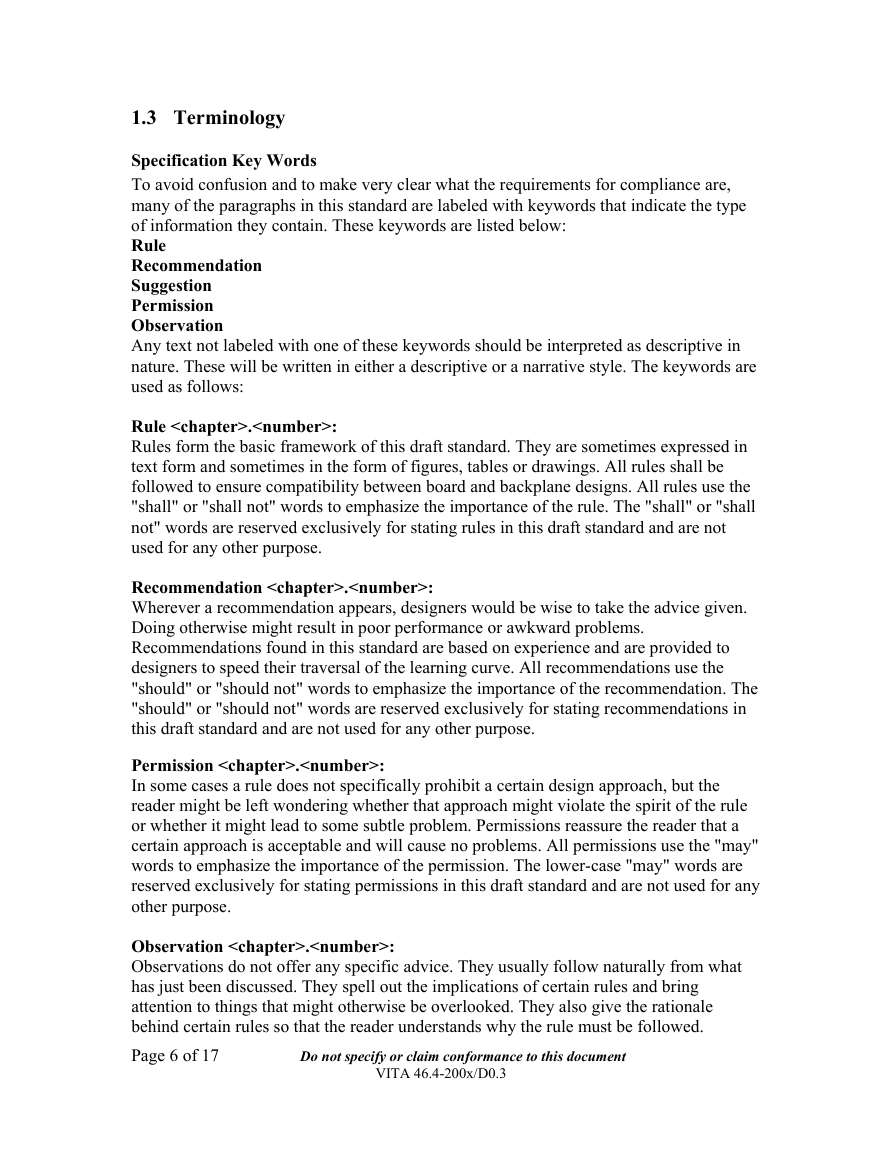
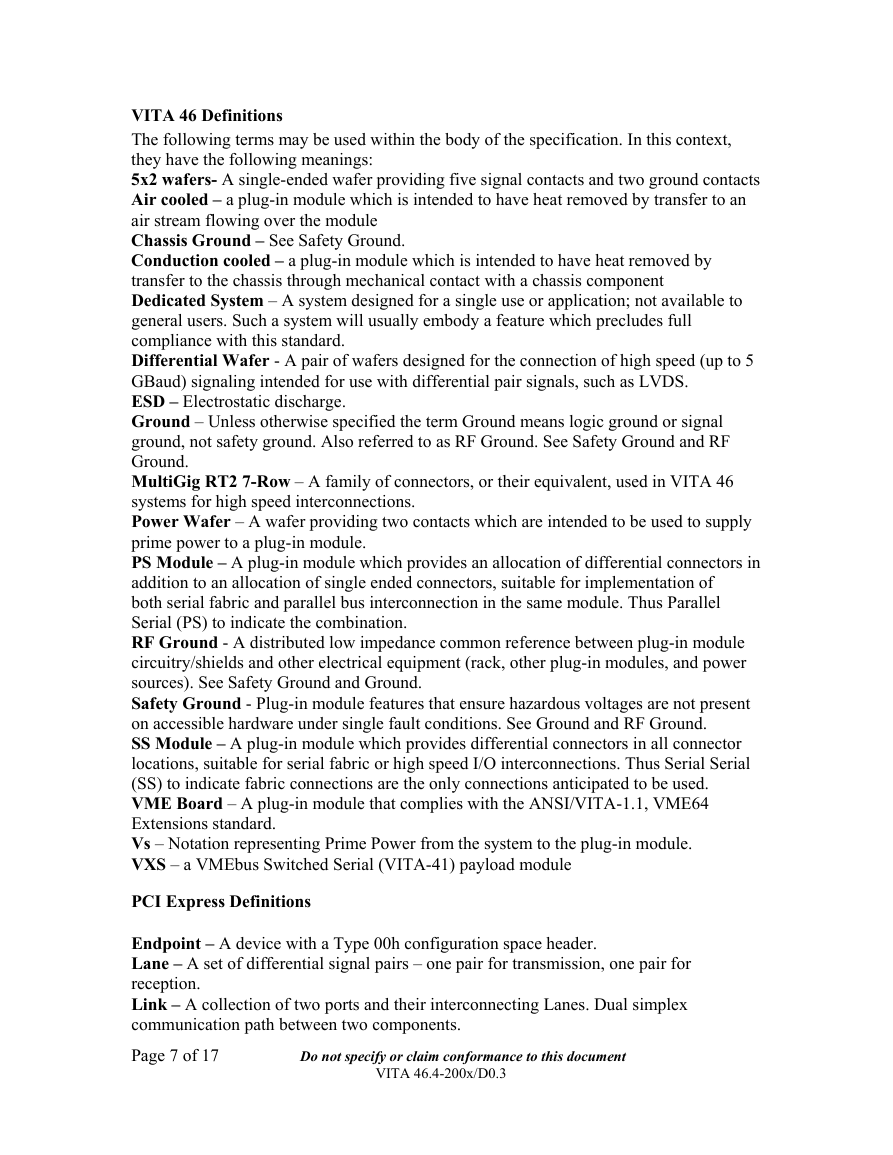
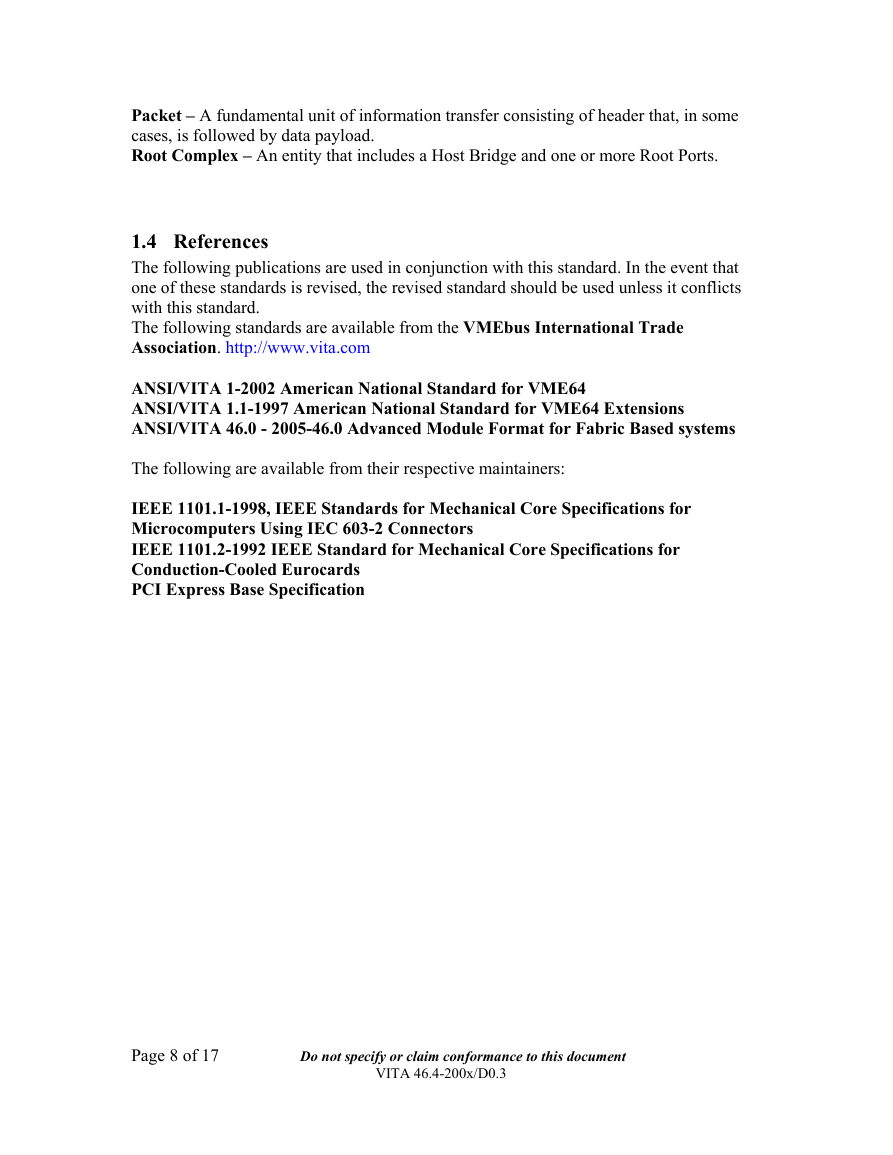








 2023年江西萍乡中考道德与法治真题及答案.doc
2023年江西萍乡中考道德与法治真题及答案.doc 2012年重庆南川中考生物真题及答案.doc
2012年重庆南川中考生物真题及答案.doc 2013年江西师范大学地理学综合及文艺理论基础考研真题.doc
2013年江西师范大学地理学综合及文艺理论基础考研真题.doc 2020年四川甘孜小升初语文真题及答案I卷.doc
2020年四川甘孜小升初语文真题及答案I卷.doc 2020年注册岩土工程师专业基础考试真题及答案.doc
2020年注册岩土工程师专业基础考试真题及答案.doc 2023-2024学年福建省厦门市九年级上学期数学月考试题及答案.doc
2023-2024学年福建省厦门市九年级上学期数学月考试题及答案.doc 2021-2022学年辽宁省沈阳市大东区九年级上学期语文期末试题及答案.doc
2021-2022学年辽宁省沈阳市大东区九年级上学期语文期末试题及答案.doc 2022-2023学年北京东城区初三第一学期物理期末试卷及答案.doc
2022-2023学年北京东城区初三第一学期物理期末试卷及答案.doc 2018上半年江西教师资格初中地理学科知识与教学能力真题及答案.doc
2018上半年江西教师资格初中地理学科知识与教学能力真题及答案.doc 2012年河北国家公务员申论考试真题及答案-省级.doc
2012年河北国家公务员申论考试真题及答案-省级.doc 2020-2021学年江苏省扬州市江都区邵樊片九年级上学期数学第一次质量检测试题及答案.doc
2020-2021学年江苏省扬州市江都区邵樊片九年级上学期数学第一次质量检测试题及答案.doc 2022下半年黑龙江教师资格证中学综合素质真题及答案.doc
2022下半年黑龙江教师资格证中学综合素质真题及答案.doc